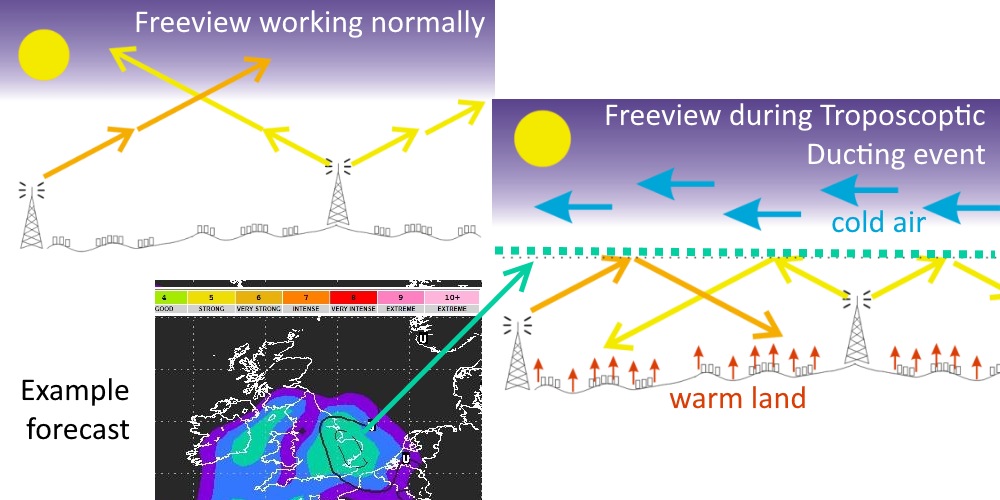Current Freeview changes make it a little less reliable

Freeview is reliable
If you enjoy watching TV using Freeview, this means that there is a wire going from the back of your TV set to an aerial on the roof of your home, flat or office. In the air. the Freeview TV signals travel in straight lines, like light, so the aerial needs to be able to “see” the top of a Freeview transmitter tower.
From the top of one of these towers is mounted a cylinder that is covered in transmission panels. This allows the Freeview signals to be sent out in a controlled pattern, for several reasons:
- It is wasteful to send the signals out into space;
- It is unhelpful to send signals over a country borders;
- It is unnecessary to send signals into mountains where no-one can get them;
- To limit the possibility of interference in a very flat area;
- Sometimes to synchronise a signal in a single frequency network area.
Tropospheric Ducting
It is quite reasonable to think that all the above conditions would remain constant over time.
It was discovered that all TV signals sent horizontally do not always just zoom off into space. From time to time, changes to air pressure cause “Inversion” and the signals can reflect down as if there were a mirror at cloud level. Sometimes the signals can be found 800 miles beyond their expected locations.

The way the digital TV signals are encoded incorporates ways to reject these unplanned, unexpected interference. There is a limit to what can be done in all instances.
Whilst it is possible to predict where the “mirrors” can occur in the atmosphere – see http://www.dxinfocentre.com/tropo_nwe.html - the loss of Freeview channels from your box can then depend upon:
- The Freeview multiplex you are watching (the ones in DVB-T2 mode are safer);
- The direction your aerial points because which TV transmitters are in a line projecting from your roof to your normal transmitter AND which transmitters are in line 180 degrees from the above one;
- If your aerial system has an amplifier (that might get overloaded and stop working);
This means that moving a few streets away can make the difference between no Freeview at these times and normal service during a time of Tropospheric Ducting.
People who watch satellite TV can have a similar, random problem caused by heavy rain and snowfall.
Generally, these Tropospheric Ducting events happen in the UK about the times the clocks go forward and go back, and sometimes when there is a very still, cold winter.
Why the 700MHz changes might be an extra problem
In simple terms the 700MHz changes will reduce the number of transmission frequencies for Freeview from 40 (C21 to C37, C39 to C48) to just 30 (C21 to C48, C55 and C56). This is being done in a way that keeps all the channels you can watch.
It does mean, however, that during those times of random Tropospheric Ducting it will be slightly more likely that an interfering signal might occur at any given location.
Do not adjust your set
So, please don’t blame Freeview. They are pumping out all the usual signals if this happens to you.
If it does happen, please don’t retune your equipment. It is unlikely that the problem will continue for more than a few hours at the most, and you will most likely be able to watch most other Freeview channels.
Do we need an “Inversion Effect” predictor?
Would it be useful to develop a tool to work out how bad a potential Tropospheric Ducting event might be for a given location?
See also https://ukfree.tv/article/1107052352/What_is_the_Inversion_Effect_and_why_does_it_effec
11:04 PM
Pershore
Hi
Where I reside I notice that not all TV aerials are facing in the same direction, which is normally the case.
So what exactly is the best position for my aerial, and which transmitter are we to direct the aerial to, I assume it is Sutton Coldfield, but some are pointing towards the Wrekin.
Poscode is WR10 2BP
| link to this comment |
Derek's: mapD's Freeview map terrainD's terrain plot wavesD's frequency data D's Freeview Detailed Coverage
11:28 PM
Derek: Sutton Coldfield and Lark Stoke should both be good at your location. The Wrekin doesn't appear on your coverage prediction at all. I would go with Sutton Coldfield and it will give you more channels (both transmitter carry the same BBC & ITV region).
| link to this comment |
11:44 AM
my post code is tf91bu and im on the wrekin,what would be the best transmitter opton to get the most hd channels?
thanks
| link to this comment |
12:24 PM
paul rushton: You could get more HD channels from Sutton Coldfield but reception of COM4, COM5 & COM6 would be much worse than you get from The Wrekin.
| link to this comment |
1:58 PM
I am receiving my tv from Waltham txt mast and according to the Internet should get Pick DAVE on chan56 but cannot get any signal. I am receiving a poor intermitant signal on chan 45. Does any one know what chan I should be on nw
| link to this comment |
3:36 PM
John P: Pick and Dave are on COM5 which changed frequency at Waltham yesterday and can now be found on UHF channel 37. The weak COM5 signal on C45 is probably from Sutton Coldfield.
| link to this comment |
8:51 PM
I receive my signal from Winter Hill, but I'm in a marginal area and have to wait until it's raining in Wales before re-tuning (it reduces the Welsh signal) and I can then get most of the W/H channels without a problem.
One thing that does cause me problems is that Channel 54 with HD channels etc is broadcast at 737.8mhz. My Philips box lets me do a manual retune so I can get all the other Channels that were missed, but the closest I can set the box to is 738.0mhz. I'm looking at it now and it's saying "no signal". (It seems that the 0.2 difference is very important).
Any suggestions?
| link to this comment |
2:21 PM
Has transmission of the OA program guide altered in any way as a result of these changes? My EPG is now almost totally empty (on a 2010 model TV) and support claims that this is why and that they are unable to fix it!
| link to this comment |
11:36 PM
So only Freeview will get interference from the new mobile phone transmissions? I don't suppose the fact that it is free to users (apart from the TV licence fee) and does not have customers paying millions to media corporations has affected the choice of which TV transmission system would be encroached on?
| link to this comment |
7:08 PM
Despite the article "Freeview changes make it less reliable" The reasons and explanations offered laid out in
the article are entirely unhelpful. Terrestial TV digital TV is completely useless. It really is totally unreliable as a source of TV reception. Channels come and go due to poor signal problems. Last week for example Channel 81 was suffering from breaking up and freezing pictures, while channel 82 Vintage TV was fine. For the last few days it has been O.K. Now Vintage TV (Channel 82) has gone missing due to a weak signal. This is an on going
problem the service offered by Freeview really is not fit for purpose. It is unacceptable to say please do not
blame Freeview for disruptions and loss of service. If you are a service provider you should provide that service
no matter what. No excuses, no if buts, or maybes. I am absolutely fed up with terrestial digital TV because reception is so hit and miss and unreliable.
| link to this comment |
